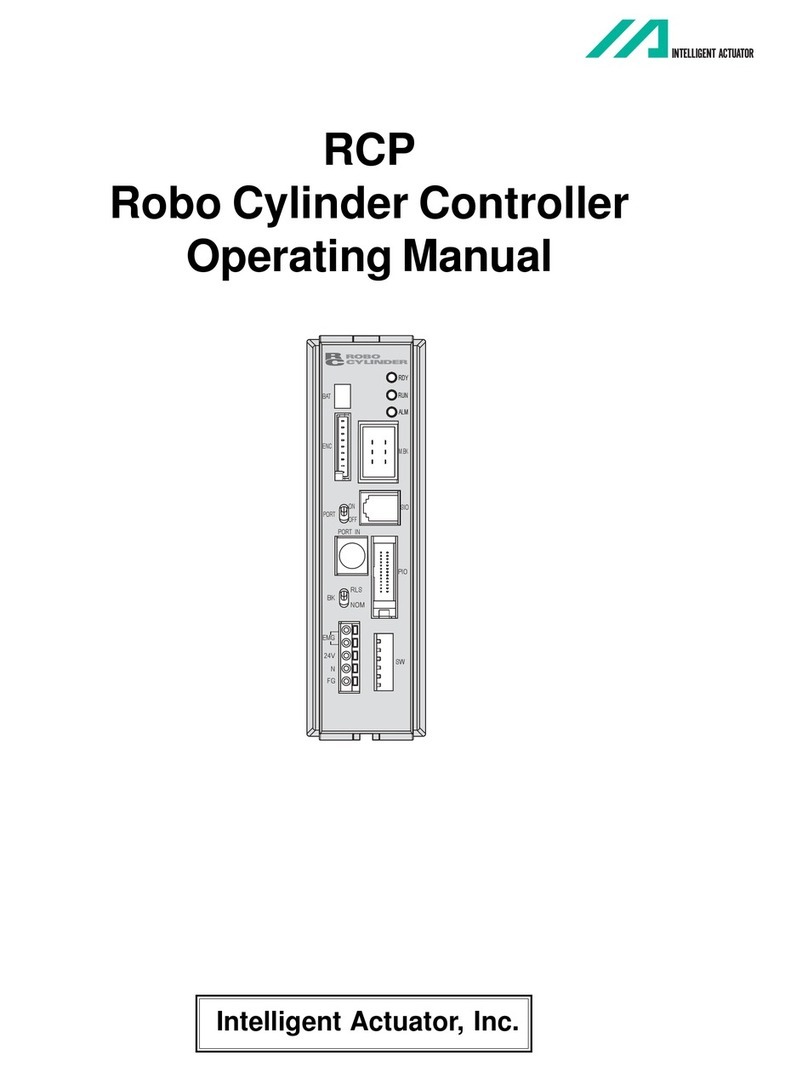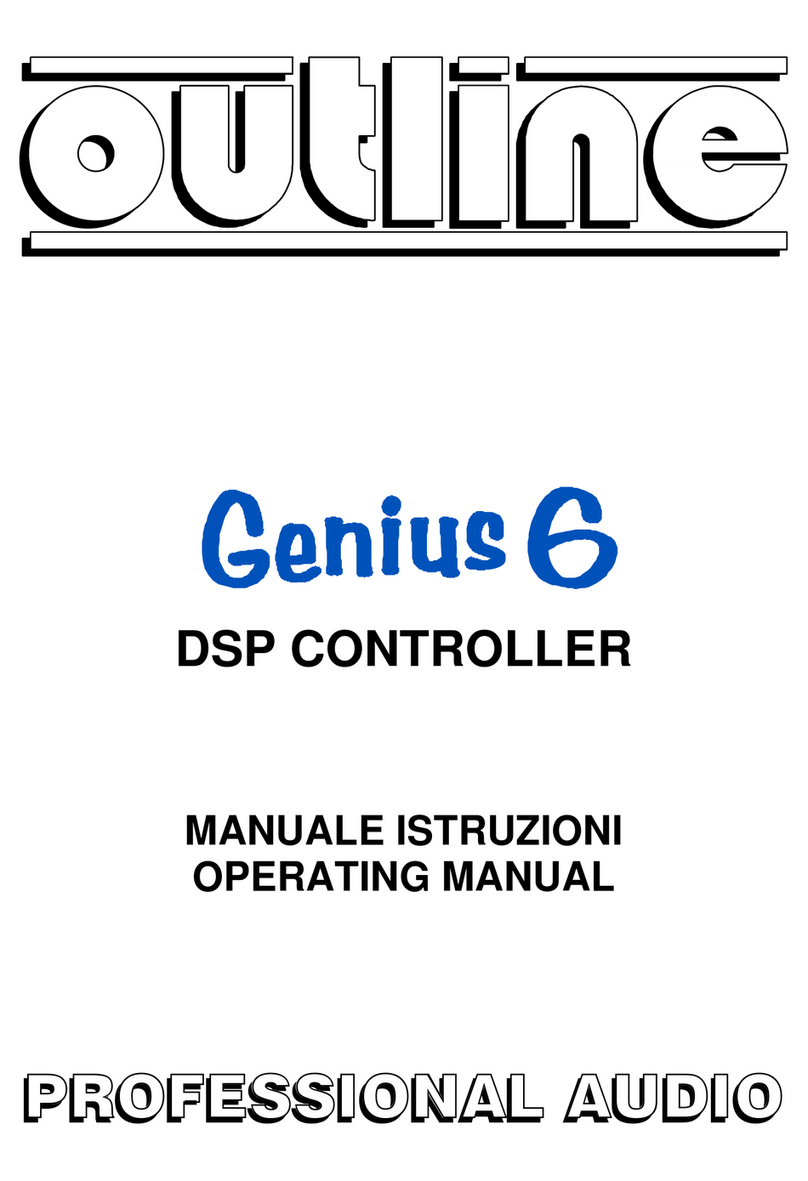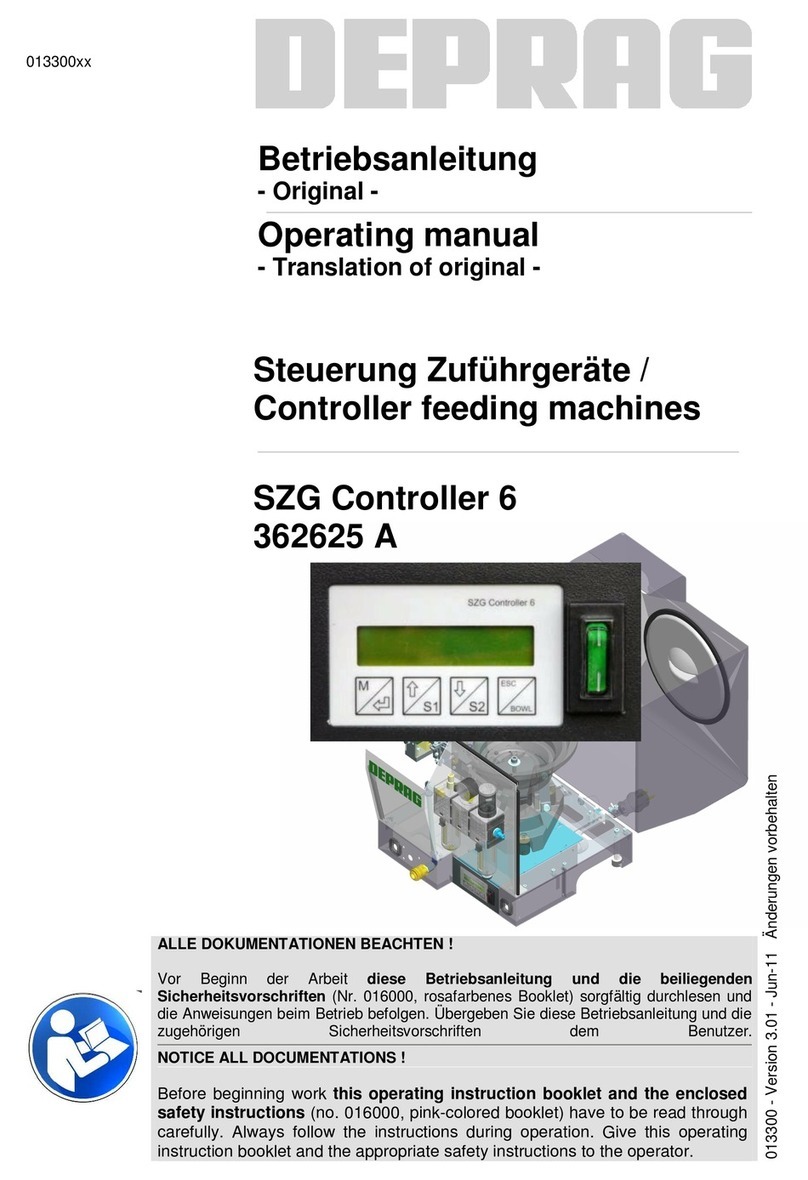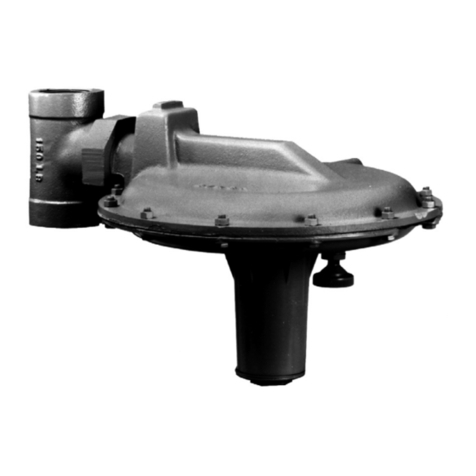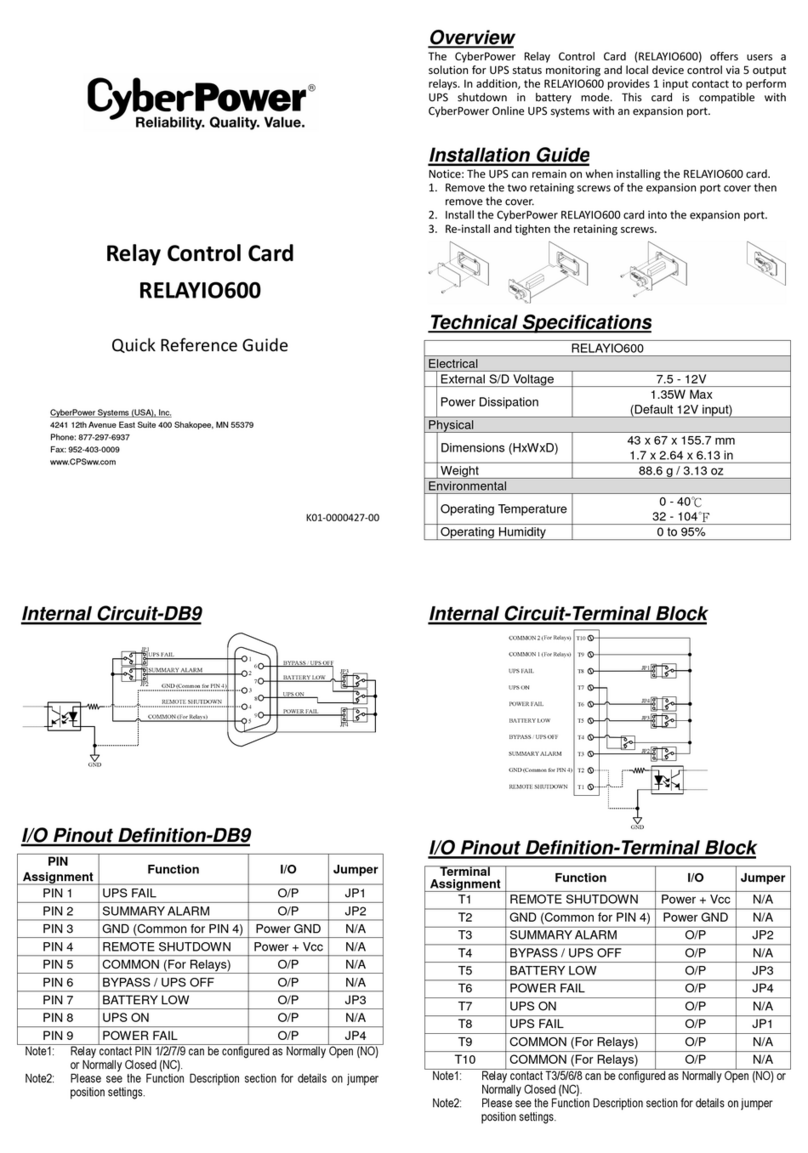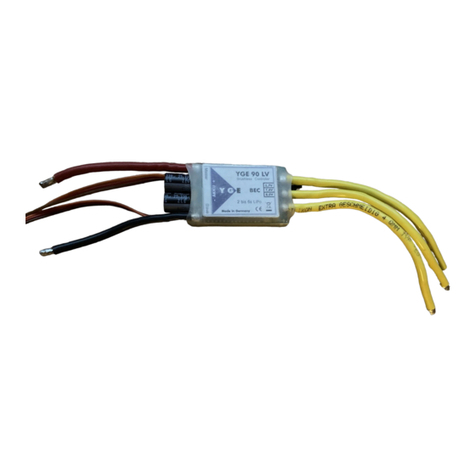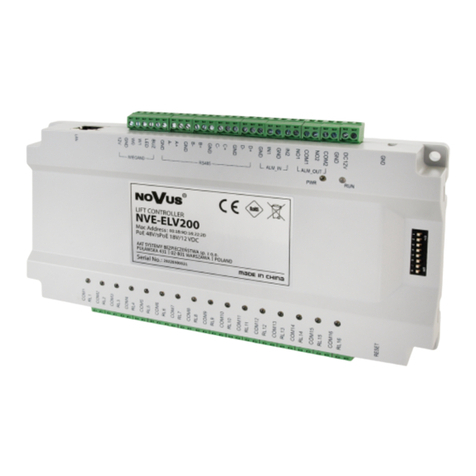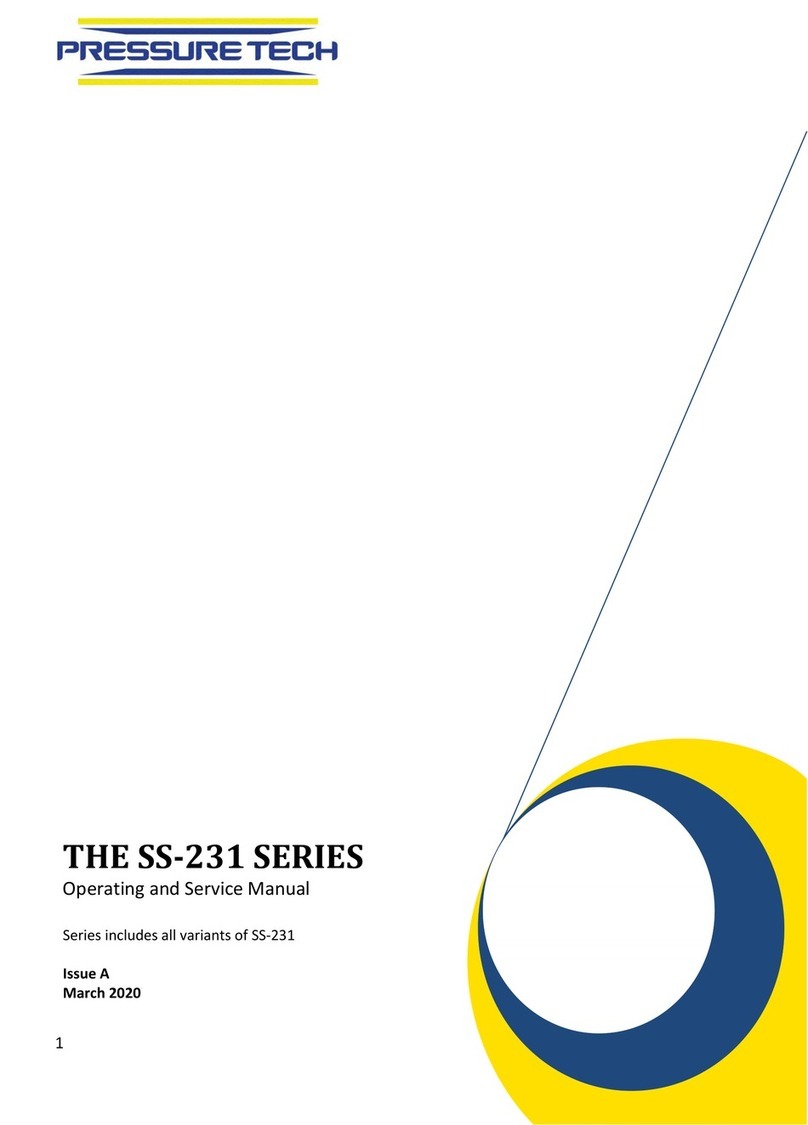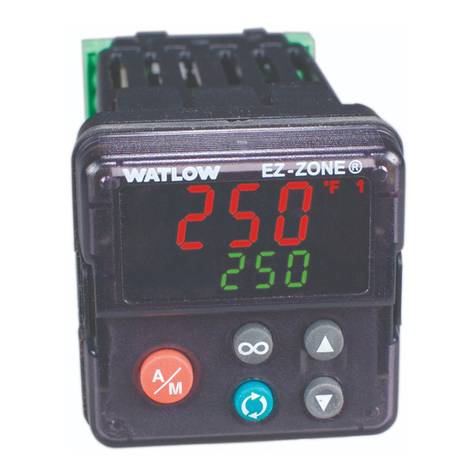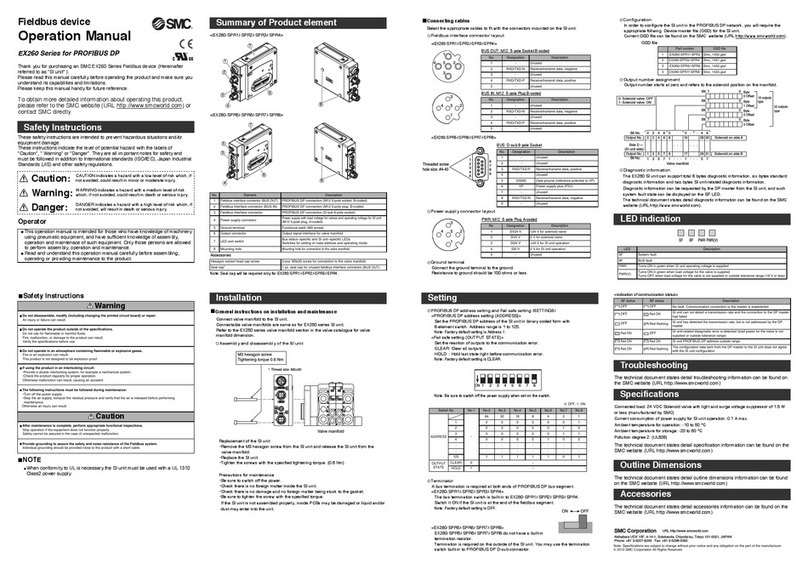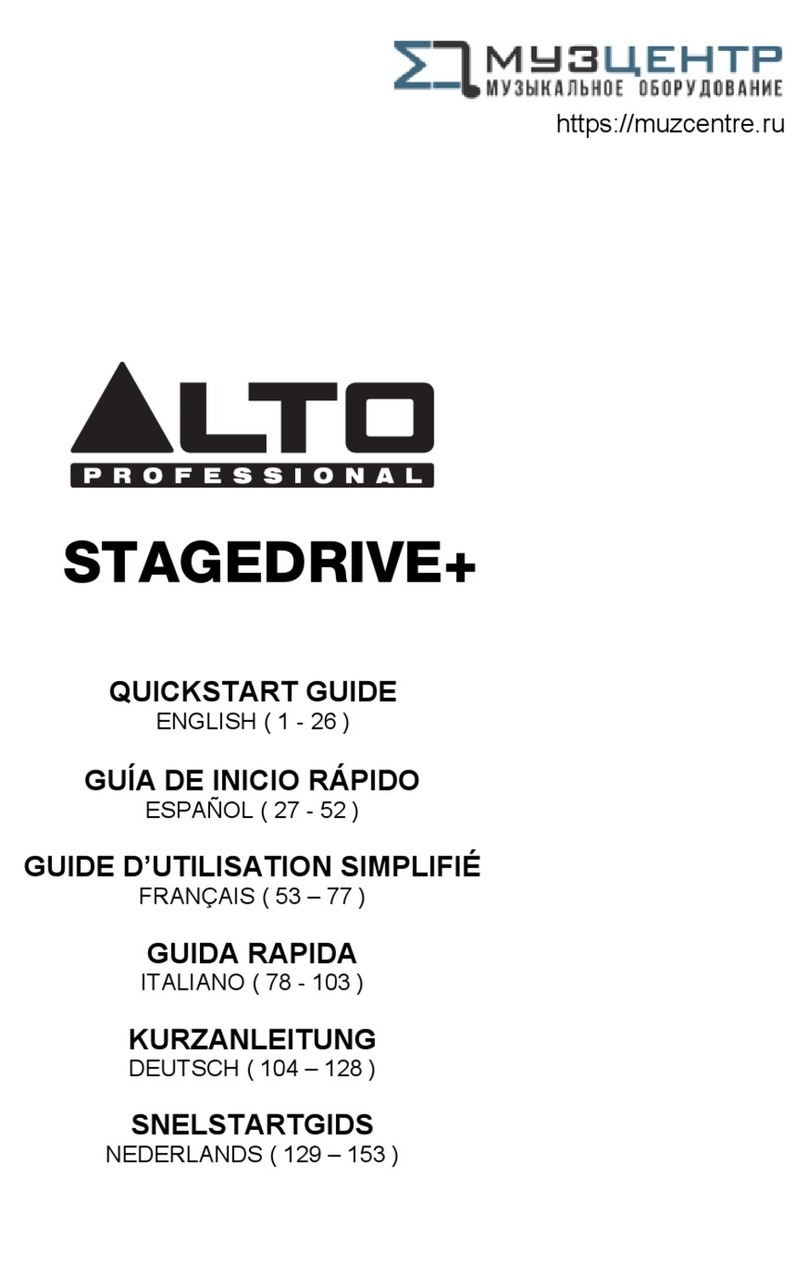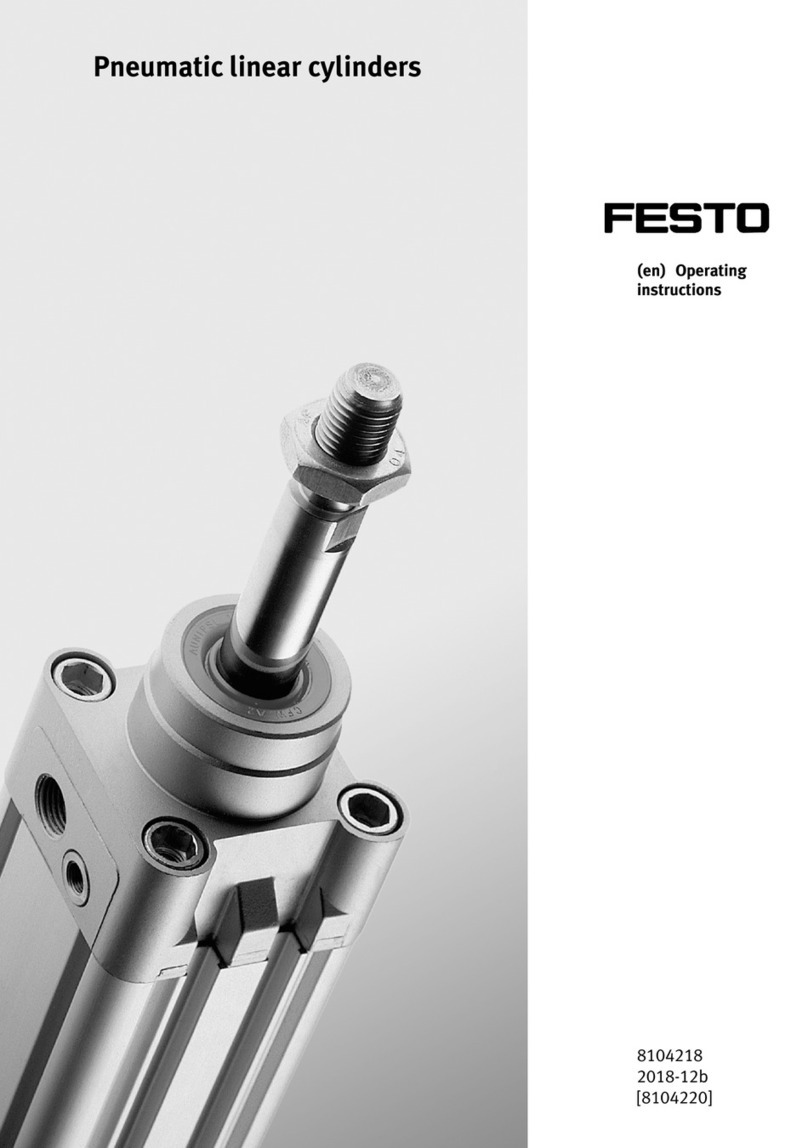Intelligent Actuator IS-D CR User manual

IS-D CR Actuator
Operating Manual
Intelligent Actuator, Inc.

This publication was written to assist you in better understanding this part of your IA system. If you require further assistance, please
contact IA Technical Support. For Central and East Coast Time ones, please call our Itasca, IL office at 1-800-944-0333 or FAX 630-
467-9912. For Mountain and Pacific Time ones, please call our Torrance, CA office at 1-800-736-1712 or FAX 310-891-0815; Monday
thru Friday from 8:30 AM to 5:00PM.
Intelligent Actuator, Inc.
U.S. Headquarters
2690 W. 237th Street
Torrance, CA 90505
310-891-6015 / 310-891-0815 FAX
Intelligent Actuator, Inc.
Midwest Regional Office
1261 Hamilton Parkway
Itasca, IL 60143
(630) 467-9900 / 630-467-9912 FAX
www.intelligentactuator.com
© April 2000 Intelligent Actuator, Inc. All rights reserved.
No portion of this publication may be reproduced, stored in a retrieval system, or transmitted, in any form or by any means, electronic,
mechnical, recording, or otherwise, without the prior written permission of Intelligent Actuator, Inc.
Disclaimer
The information and technical data contained herein are subject to change without notice. Intelligent Actuator, Inc. assumes no responsibility
responsibilityfor any errors or omissions regarding the accuracy of the information contained in this publication.

1. Foreword .................................................................................................................................................. 1
2. Outline ...................................................................................................................................................... 1
3. Safety Precautions .................................................................................................................................. 1
3-1 Basic Operating Instructions .............................................................................................................. 1
3-2 Maintenance and Inspection ............................................................................................................... 1
4. Warranty ................................................................................................................................................... 2
4-1 Warranty Period ................................................................................................................................. 2
4-2 Scope of Warranty .............................................................................................................................. 2
5. Names of the Parts ................................................................................................................................. 3
. Installation Environment and Noise Measures ................................................................................. 4
6-1 Handling the Packed Unit ................................................................................................................... 4
6-2 Handling the Actuator After It is Unpacked ....................................................................................... 4
7. Operating and Storage Environment ................................................................................................... 5
7-1 Operation Environment ....................................................................................................................... 5
7-2 Storage Environment ........................................................................................................................... 5
8. Installation ........................................................................................................................................... ~9
8-1 Installing the Main Body ..................................................................................................................... 6
8-2 Attaching the Slider Carrying the Payload .......................................................................................... 7
8-3 Mounting Surface ................................................................................................................................ 8
8-4 Clamp Screw ....................................................................................................................................... 9
8-5 Mounting the Connector Box and T-Slot (option) ...............................................................................9
9. Connecting the Controller .................................................................................................................. 10
9-1 Standard Wiring Specifications .......................................................................................................... 10
10. Caution Regarding Usage. ............................................................................................................11~15
10-1 Regarding Maximum Speed ............................................................................................................. 11
10-2 Load on the Actuator ...................................................................................................................... 12
10-3 Setting the Home Position ............................................................................................................... 13
10-3-1 Principle of the Homing Operation ............................................................................................ 13
10-3-2 Fine Control of the Home Position ............................................................................................ 14
10-3-3 Changing Home Direction ......................................................................................................... 14
10-4 Regarding the Stainless Sheet Area ................................................................................................ 14
10-5 Regarding the Vacuum Flow ........................................................................................................... 15
10-5-1 Recommended Vacuum Flow ................................................................................................... 15
10-5-2 Regarding the Vacuum Coupling ............................................................................................... 15
11. Maintenance ................................................................................................................................... 1 ~20
11-1 Maintenance Schedule ..................................................................................................................... 16
11-2 Visual Inspection of the Machine Exterior ....................................................................................... 16
11-3 Cleaning the Exterior ....................................................................................................................... 16
11-4 Inspecting the Interior ...................................................................................................................... 17
11-5 Cleaning the Interior ........................................................................................................................ 19
11-6 Lubricating the Guide Bearing Block ............................................................................................... 19
11-6-1 What Grease to Use .................................................................................................................. 19
11-6-2 How to Lubricate ...................................................................................................................... 19
Table of Contents

IS-D CR Actuator
Page 1
1. Foreword
Thank you for purchasing the IS-D CR Actuator. This manual explains the structure, correct operation and maintenance
of the IS-D CR Actuator. Please read this manual carefully before using the actuator. For more complete information on
operating the actuator, please refer to the controller operating manual.
2. Outline
A shield and evacuation system enables the new ISD-CR actuators to maintain a Class 10 level. A thin stainless steel
shield is used to keep particles generated inside the actuator from migrating to the outside environment. In addition,
any particles that are generated are purged from the system through a standard vacuum connector port which has
been designated for quick and easy hookup to a vacuum source.
3. Safety Precautions
3-1 Basic Operating Instructions
•Please do not attempt to use or operate the actuator in any manner not indicated in this manual or the
controllermanual.
• Please be sure to use only the cable provided by IAI to connect the actuator and controller.
• Please do not allow people within the moving range of the unit when it is in operation or when the power is
ON since this is dangerous.
3-2 Maintenance and Inspection
• When doing maintenance and inspection work, always shut down the controller power first.
• When doing inspection, make sure that no one can inadvertently turn the power ON.
• Make sure that a sign indicating work in progress is clearly visible.
• If several persons are working, be sure to watch out for each other's safety. In particular, check before
turning power ON or OFF and let others know if you are doing work involving axis movement.

IS-D CR Actuator
Page 2
4. Warranty
All ISD-CR Series actuators are individually tested on a clean bench located within a class 10 cleanroom. They are
sealed and packed within a class 10 cleanroom before shipment. Data is fully assembled for each CR Series and can
be provided upon request. Currently, there is no industry standard to measure cleanliness. In general, particles are
measured in the area of operation. However, this type of measurement method can be influenced by the capacity of
the cleanroom itself. Therefore, the ISD-CR Series of Intelligent Actuator satisfactorily meets Class 10 ratings, but is
not absolutely guaranteed.
4-1 Warranty Period
The warranty period is one year after IAI America ships the unit.
4-2 Scope of Warranty
If a breakdown occurs within the period specified above and is due to the manufacturer's error, we will
repair the unit at no cost. However, the following items are not covered by this warranty.
wFaded paint or other changes that occur naturally over time.
wConsumable components that wear out with use.
wUnit seems to be noisy or similar impressions that do not affect machinery performance.
wDamage resulting from improper handling by the user or lack of proper maintenance.
wAny alterations made by other than IAI or its representatives.
wBreakdowns caused by using controllers made by other manufacturers.
wAny damages caused by fire and other natural disasters or accidents.
The warranty pertains to the purchased product itself and does not cover any damages that might arise from a
breakdown of the supplied product. Any repairs will be done at our factory. Even if the product is still covered
under the warranty period, we will assess a separate charge for sending technicians to the customer's site.

IS-D CR Actuator
Page 3
5. Names of the Parts
The name of the actuator parts are indicated below. The left and right sides are indicated by looking at the actuator
from the motor end with the actuator set down horizontally. Front end means the side opposite the motor end.
Sheet stopper plate Side cover Cable
Slider cover Motor cover
Stainless sheet
Left Side (L)
Suction coupling
Front cover
Base
Slider Rear cover
Right Side (R)
Reversed
motor side
(front area) Motor side

IS-D CR Actuator
Page 4
6. Transporting, Handling
6-1 Handling the Packed Unit
Unless there are special instructions, the system is shipped with each axis packed separately. Please take care
that the shipping box is not dropped or subjected to strong impact during transport.
• The operator should not carry heavy shipping boxes by himself.
• If the shipping box is left standing, it should be in a horizontal position.
• Do not climb on top of the shipping box.
• Do not place heavy objects on top of the shipping box.
6-2 Handling the Actuator After It is Unpacked
Lift the actuator up by the base to remove it from the packing. Never grab the stainless sheet area.
• When carrying the actuator, take care not to bump it. Take particular care with the front cover, motor housing
and the encoder cover.
• Do not exert excessive force on any part of the actuator. Take particular care with the screw cover and cable.
• Please do not apply any excessive force onto each part of the actuator. In particular, please do not apply
any force onto the stainless sheet or pull the cables.
!! Warning !! Never grab the stainless sheet area!
* Please refer to Section 5 regarding the names of the actuator parts.

IS-D CR Actuator
Page 5
7. Operating and Storage Environment
7-1 Operating Environment
The actuator should be set up in an environment which meets the following criteria:
wAvoiddirect sunlight.
wAvoid radiant heat from strong heat sources such as a furnace.
wAmbient temperature should be 0 ~ 40º C.
wThe humidity should be less than 85% and there should be no condensation.
wAvoid exposure to corrosive or combustible gases.
wThe area should have very little dust and be suitable for normal assembly operations.
wAvoid exposure to oil mist or fluids used in cutting.
wThe unit should not be subject to vibrations greater than 0.3G.
wAvoid surroundings with extreme electromagnetic waves, ultraviolet rays and radiation.
In general, the environment should be one in which an operator can work without protective gear.
7-2 Storage Environment
The storage environment should be similar to the operating environment. In addition, you must take precautions
against condensation if the unit is to be stored for a long period of time. Unless there are special instructions, we
do not include moisture absorption agents when shipping the unit. If you are storing the unit where condensation
might occur, then you must treat the entire packing or treat the unit itself after it is unpacked to prevent conden-
sation. The unit can withstand up to 60ºC during a short storage interval but only up to 50ºC if the storage period
is longer than one month.

IS-D CR Actuator
Page 6
8. Installation
We'll describe the installation process using a single axis unit.
8.1 Installing the Main Body
In this section, we will explain the mounting method for a single axis application.
!! Warning !!
!! Since the tap is a stopper hole, please be careful when setting the bolt length. Inadequate
bolt usage may cause tap hole breakdown as well as lead to lack of intensity in actuator
mounting, thus lowering precision and may cause an accident.
Machine Type Tap diameter Tap Effective length A
Small M6 17mm 70mm
Medium M8 20mm 90mm
Large M8 20mm 120mm
Tap effective length
Tap diameter
A

IS-D CR Actuator
Page 7
• There are tapped holes in the slider where you can affix the payload. To do this, follow the mounting
procedure used for the main body.
• If you are anchoring the slider and moving the main body, attach the slider using the tapped holes.
• The slider has two reamed holes which are used to reproduce the correct positioning when dismounting and
reattaching the slider. Use only one of the holes when fine adjustments to the perpendicularity are required.
8.2 Attaching the Slider Carrying the Payload
Slider Tap Hole Diameter and Reamer Diameter
Machine Type Tap diameter Tap depth A B C Reamer Hole Reamer Depth
Small M6 13mm 70mm --- 60mm φ6H10 10mm
Medium M6 18mm --- 70mm 80mm φ6H10 10mm
M8 18mm 90mm --- φ6H10 10mm
Large M8 20mm 120mm 90mm 105mm φ6H10 10mm
Reamer Hole
Tap Hole
A
B
C

IS-D CR Actuator
Page 8
• The mounting table should have sufficient rigidity to avoid generating vibration.
• The surface where the actuator will be mounted should be machined or be equally level and the flatness
tolerance between the actuator and the table should be within 0.05mm.
• Provide enough space around the actuator to permit maintenance work to be done.
Caution:
As the diagram above shows, the slider travelling plane is the reference plane for the actuator
base and the lower surface. When travelling precision is required, use this as the reference
plane for mounting.
Please follow the diagrams below for machining to mount on to the frame using the base surface:
8.3 Mounting Surface
Machine Type A dimensions (mm)
Small 2~5
medium 2~5
Large 2~5
Standard side
(Base side area) Standard side
(Base side area)
Under R0.3
A

IS-D CR Actuator
Page 9
8-4 Clamp Screws
• Please use hexagon sockets as the screws for mounting the base.
• For the bolts, we recommend high strength bolts of ISO- 10.9 or
higher.
• Make sure the bolt and screw engagement length is the following
value or greater:
Steel screw →same length as the nominal diameter
Aluminumscrew → twice as long as the nominal diameter
• When attaching the base to a mounting table, use the special washer made for high strength bolts that comes with the
actuator if the bolt is M8 or larger. This is unnecessary for M6 or smaller bolts. Do not use a common spring washer.
• The recommended screw torque is given below.
Actuator
Bolt mounted
side
Hexagon sockets
(High strength bolts)
Washer for high strength bolts
When the bolt surface is aluminum
and M8 bolt is used
Effective engagement
length
8-5 MountingtheConnectorBox and the T-Slot(Option)
There are T-slots (width of slot 4mm) in the base for mounting external devices such as a connector box. When
using the wiring kit, mount the connector box using these T-slots. Use the slots as necessary to mount sensors or
to anchor cables.
Caution:
We recommend a square nut for the T-slot but you can also use a hexagonal nut.
When mounting, check the bolt length to make sure the end does not touch the bottom of the
T-slot. Be especially careful during tightening.
Screw nominal
diameter
Screw Torque
When the rod surface is steel When the rod surface is aluminum
M5 7.5N • m (0.77kgf • m) 4.3N • m (0.44kgf • m)
M6 12.9N • m (1.32kgf • m) 6.7N • m (0.68kgf • m)
M8 31.3N • m (3.19kgf • m) 14N • m (1.43kgf • m)
4.5 1.5
4.3
7.3
Square Head Nut
(Or Hexagon Nut)
Space between
bolt tip
Bolt
Mounting part

IS-D CR Actuator
Page 10
9. Connecting the Controller
We will explain the controller wiring for a single axis actuator.
9-1 Standard Wiring Specifications
For a single axis actuator, unless otherwise specified we attach a standard 3 meter cable (5 meter option) to
the actuator when we ship the unit. Please attach the cable end directly to the controller.
• Although we use cable that is resistant to bending fatigue, it is not robot cable. Please avoid housing the
cable in a wire duct with a small bending radius.
• In an application where the cable cannot be anchored, try to place the cable where it will sag only under its
own weight or use dedicated cable hose for large radius wire duct to limit the load on the cable.
• Do not cut the cable to lengthen, shorten, or reconnect it.
• Do not pull on the cable or use excessive force to bend it.
If you wish to alter the cable, please consult with IAI before doing so.

IS-D CR Actuator
Page 11
10. Caution Regarding Usage
10-1 Regarding Maximum Speed
Our IS Protective stainless sheet (ISD) specifications are restricted to a maximum speed according to
the chart below.
Restriction in Stroke and Maximum Speed (unit: mm/s)
Caution:
Please obey the maximum speed restriction in regards to each actuator. Failure to do so
will increase noise level due to ball screw axis resonance as well as cause oscillation
occurrence, thus leading to a shorter machine life span.
In addition, if you wish to operate multiple actuators simultaneously, when operating
each actuator independently, please create the program in accordance with the actuator
that has the lowest maximum speed setting (see chart above).
Make sure to confirm the actuator maximum speed before creating a program.
Machine
Type Capacity
WLead
mm
Stroke (mm)
<500 600 700 800 900 1000 1100 1200
Small 60
4 200 190 --- --- --- --- --- ---
8 400 380 --- --- --- --- --- ---
16 800 760 --- --- --- --- --- ---
Medium
100
5 250 250 225 180 150 125 --- ---
10 500 500 455 365 300 250 --- ---
20 1000 1000 915 735 600 500 --- ---
200 10 500 500 455 365 300 250 --- ---
20 1000 1000 915 735 600 500 --- ---
Large 200 10 500 500 500 465 380 320 270 230
20 500 500 1000 930 765 640 545 465
400 20 1000 1000 1000 930 765 640 545 465

IS-D CR Actuator
Page 12
10-2 Load on the Actuator
• Do not exceed the load shown in the load specification column. Please make note of the slider moment,
allowable overhang length and the load weight.
Allowable Load Moment
Allowable Overhang Length
• The center of gravity for the mounted object is at the halfway point of the overhang length.
Machine Type Ma Mb Mc
Small 28.4N • m (2.9Kgf • m) 40.2N • m (4.1Kgf • m) 65.7N • m (6.7Kgf • m)
Medium 69.6N • m (7.1Kgf • m) 99.0N • m (10.1Kgf • m) 161.7N • m (16.5Kgf • m)
Large 104.9N • m (10.7Kgf • m) 149.9N • m (15.3Kgf • m) 248.9N • m (25.4Kgf • m)
Machine Type Ma Direction (mm) Mb Direction (mm) Mc Direction (mm)
Small Under 450 Under 450 Under 450
Medium Under 600 Under 600 Under 600
Large Under 750 Under 750 Under 750
Mc
Mb
Ma
Mb, Mc Direction
L
Ma Direction
L
Moment Direction Allowable overhang length

IS-D CR Actuator
Page 13
Y-Axis
X-axis
The Ma, Mc moment placed on
the slider needs to be under
1/2 of the rated when used.
• When the actuator is used in an X-Y configuration, the Ma and Mc moments of the Y-axis are derated to
1/2 of the rated value due to the actuator not being fully supported (see diagram below).
Caution:
Applying excessive load moment will physically shorten the guide life span.
In addition, any usage with an excessive allowable overhang may lead to oscillation
occurrences and other negative influences that affect the guide life span.
10-3 Setting the Home Position
10-3-1 Principleof theHomingOperation
IA performs homing in the following manner.
The moving direction is determined by the parameters set by the homing command.
The software senses the mechanical end in the homing operation.
The slider reverses direction when this end is reached and the place where the Z phase signal is detected
becomes the reference point.
The slider travels further by an offset amount defined by the parameters and this position becomes home.

IS-D CR Actuator
Page 14
As long as the homing direction is the same, you can make fine adjustments to the home position for each actuator
by changing the parameters based on this value. Adjustments are made as follows:
Initiate the homing operation and confirm home.
After that, move to the desired home position, check the difference and adjust the parameters.
You can reset the parameters on the plus side in the advancing direction (minus direction is not allowed).
If you allow for ample offset amount the movement range is that much more limited. If the offset is
greater than 1mm, you will have to reset the stroke soft limit.
10-3-3 ChangingHome Direction
If you change the home direction after the unit is delivered, the move direction parameter must be changed and
you may need to adjust the encoder Z-phase so please contact IAI.
Machine Type Reverse distance from
the mechanical end (~mm)
Small 5
Medium 5
large 5
10-4 Regarding the Stainless Sheet Area
• Since the stainless sheet is held by magnets, in case an excess quantity of magnetic substances such as dust and
steel exist in the environment, these substances will be attracted into the magnetic area, causing increase wear of
possible failure. Therefore, please try to avoid using under such environments.
• Applying adhesive and coating materials containing viscous substances on top of the stainless sheet will lead
to failure in the slider movement as well as cause sheet breakage, please avoid using such materials.
•Applying local force onto the stainless sheet will cause deformation, and lead to incompatibility, so please
be careful. In addition, please do not grab or push the stainless sheet area during the setting and transfer to
avoid sheet breakage.
• Please use alcohol to remove any dirt off of the stainless sheet.
10-3-2 FineControlofHomePosition
The number of motor revolutions from the time the slider hits the stopper to when the Z phase signal is generated
is adjusted when the unit is shipped. The standard value of the backing distance when the slider hits the stopper,
reverses and then stops at the home position is,

IS-D CR Actuator
Page 15
10-5 Regarding the Vacuum Source
Through the employment of a vacuum coupling, the IS-D CR Actuator is able to maintain a class 10 (0.1µm) compliance.
The chart below indicates the recommended vacuum flow according to the rated speed of each machine type.
10-5-1 RecommendedVacuumflow
Machine Type Rated Speed
(mm/sec) Vaccuum Flow (NI/min) Pressure (mm/Aq)
ISD-S-4- - -CR 200 10 -3
ISD-S-8- - -CR 400 20 -6
ISD-S-16- - -CR 800 30 -13
ISD-M-5- - -CR 250 15 -4
ISD-M-10- - -CR 500 30 -12
ISD-M-20- - -CR 100 70 -40
ISD-L-10- - -CR 500 30 -10
ISD-L-10- - - CR 1000 90 -60
• If you happen to have an air flow equipment, please confirm its capabilities. If you wish to use other equipment such
as vacuum pump or blower, please refer to the values indicated in the above table for recommended air flow.
10-5-2 RegardingtheVacuumCoupling
The vacuum coupling is a quick-connect fitting which uses a commercial air tube φ12 and is designed for
easy connection. The model type for the quick-connect coupling is listed below:
SMC ElboUnion: KQL16-02S-X2
As for the mounting direction of the vacuum coupling, unless the customer requests otherwise, the mounting is
set on the L side. However, the vacuum coupling is designed so that the mounting direction may be modified.
To modify the mounting direction, using a hexagon wrench, remove the taper plug that is closing the vacuum
hole located on the opposite side. This allows for the quick-connect coupling to be moved from its former
location to new location. Attach the quick-connect coupling to this new location and taper plug the former
location.

IS-D CR Actuator
Page 16
11. Maintenance
11.1 Maintenance Schedule
Perform maintenance work according to the schedule below.
Note 1: The above schedule assumes running time is 8 hours per day. When running time is high
such as continuous day and night operation, shorten the maintenance intervals as required.
Visual
Inspection Internal
Check Lubrication
Start of operation m
After 1 month of operation m
After 6 months of operation m m
After 1 year of operation mmm
Semiannually thereafter m
Annually thereafter mmm
11.2 Visual Inspectionofthe Machine Exterior
Check the following when doing the visual inspection.
11.3 CleaningtheExterior
Wipe off dirt with a soft cloth.
Do not use strong compressed air on the actuator as this may force dust does into the crevices.
Do not use petroleum-based solvents on plastic parts or painted surfaces.
If the unit is badly soiled, apply a neutral detergent or alcohol to a soft cloth and wipe lightly.
Body Loose mounting bolts?
Cables Damage to cables or connection to connector box?
Stainless sheet Check for foreign objects that may cause damages on the sheet
General Unusual noise or vibrations?

IS-D CR Actuator
Page 17
Step 1:
Move the slider to the motor side.
Step 2:
Use a hexagon wrench to remove
all of the screws that hold the
stainless sheet.
11.4 InspectingtheInterior
Turn the power OFF. Remove the slider cover, stainless sheet and side cover, and visually inspect the interior.
Body Loose mounting bolts?
Guide Area Check for dirt and condition of the lubrication
Ball Screw Area Check for dirt and condition of the lubrication
Visual Check of the Interior:
Make a visual check of the interior to see if there is any dust or foreign matter in the unit and check
the lubrication. Even if the grease you see around the parts is brown, the lubrication is fine as long as the
travelling surface appears shiny.
HowtoInspectthe Interior:
Step 3:
Remove the stainless sheet and
conduct an internal inspection.
Step 4:
Upon inspection, reassemble by
following the above steps in reversed
order.
Caution:
While inspecting, please do not bend the stainless sheet excessively and avoid damaging
the stainless sheet. Please wear gloves during the inspection process since the stainless sheet
tip area may be harmful. Please do not disassemble the front cover since it supports the ball
screw. If the front cover is adjusted and warps, running resistance will increase due to dislocation
of the axis center. This will shorten the life span of each area, and may cause noise occurrence.
Table of contents
Other Intelligent Actuator Controllers manuals
Popular Controllers manuals by other brands
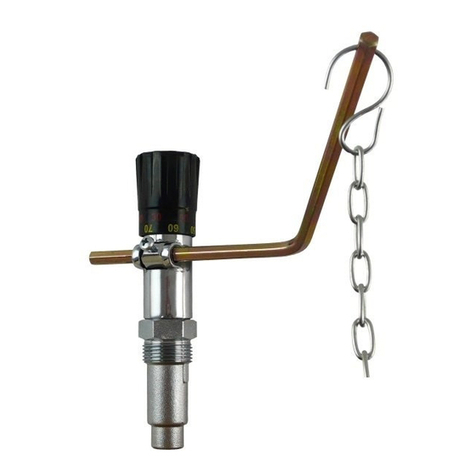
Regulus
Regulus RT4 quick start guide
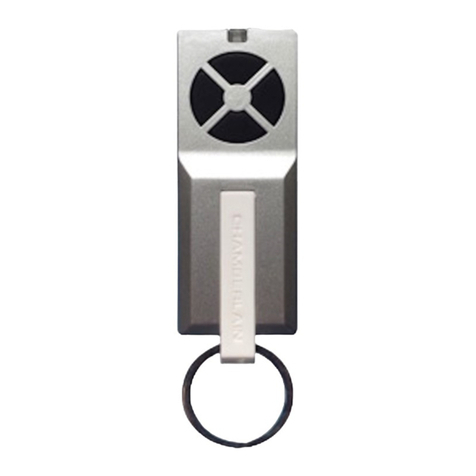
Allo RemoteControl
Allo RemoteControl CHAMBERLAIN TXR4UNI instructions
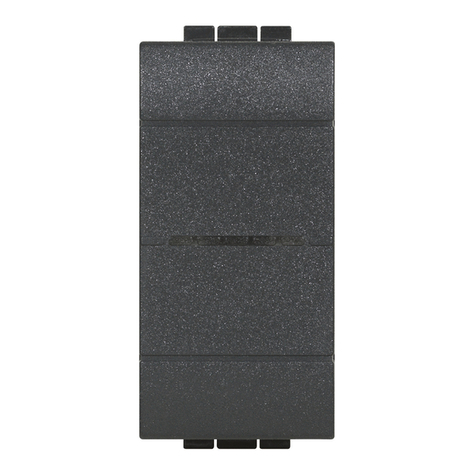
Bticino
Bticino L4003C manual

Superior Electric
Superior Electric STABILINE WHR32 Series instructions
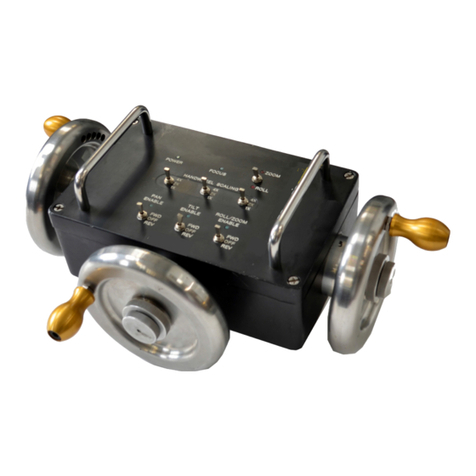
MRMC
MRMC MIMIC HRNDWHEELS quick start guide

Allen-Bradley
Allen-Bradley ControlLogix 1756-STRT3 Quick start manual
